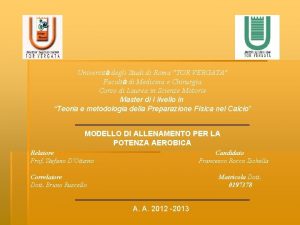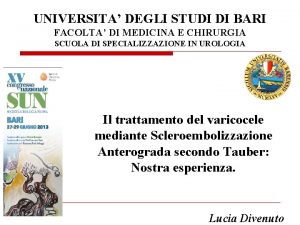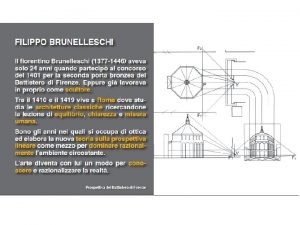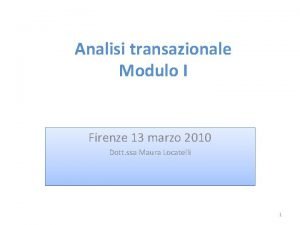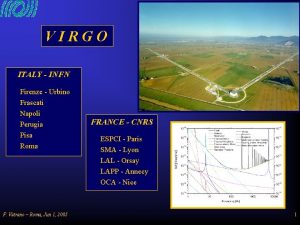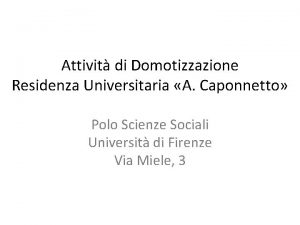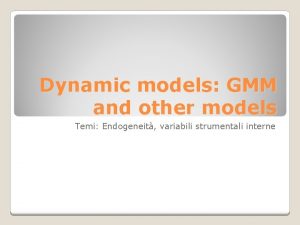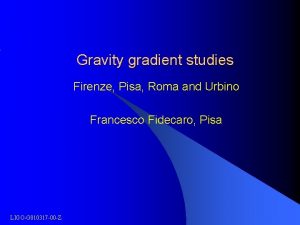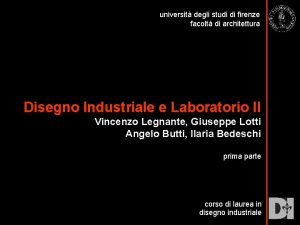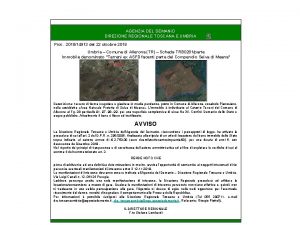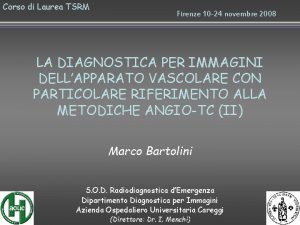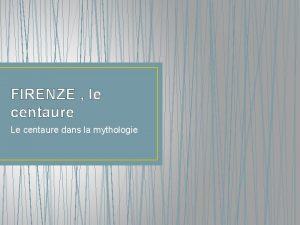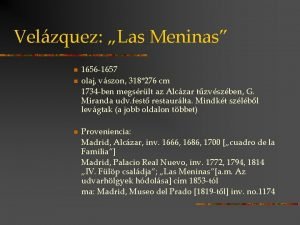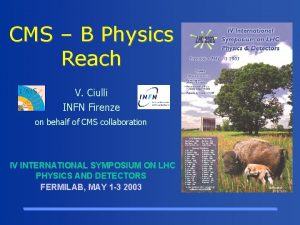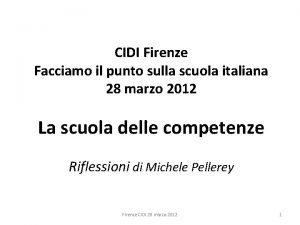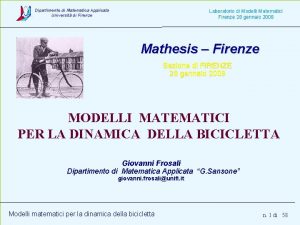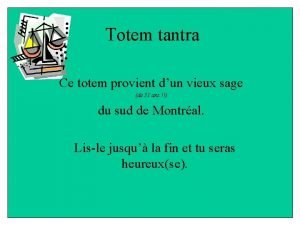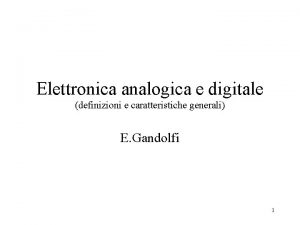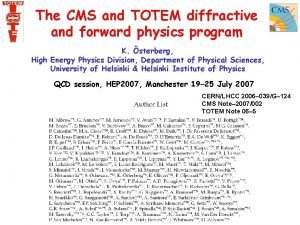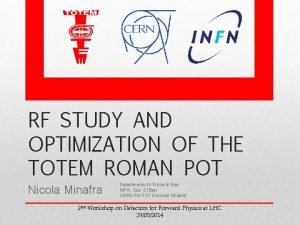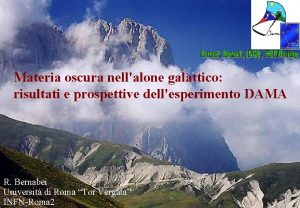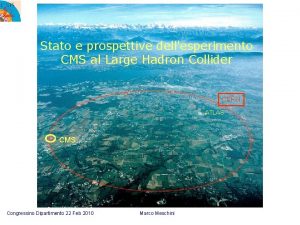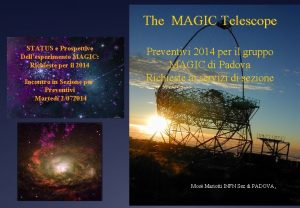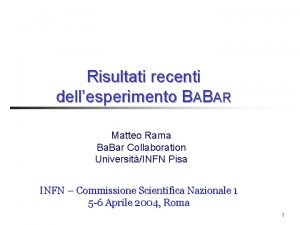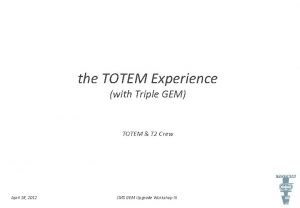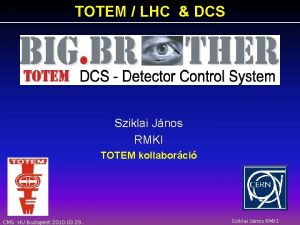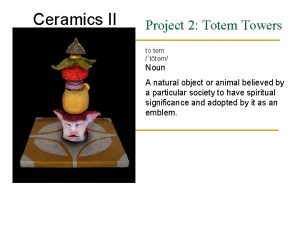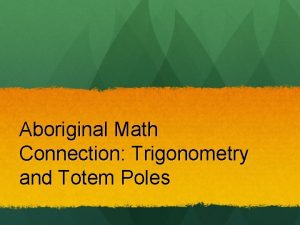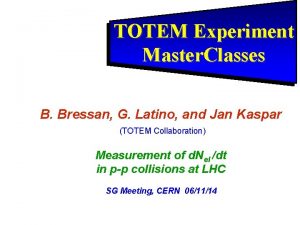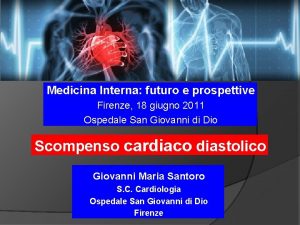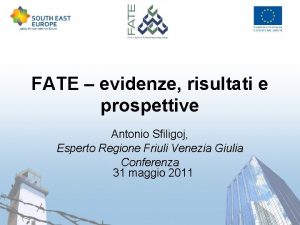Risultati e Prospettive dellEsperimento TOTEM Giuseppe Latino Firenze





![Three Methods for �T Measurement COMPETE Coll. [PRL 89, 201801 (2002)] Optical Theorem: (~ Three Methods for �T Measurement COMPETE Coll. [PRL 89, 201801 (2002)] Optical Theorem: (~](https://slidetodoc.com/presentation_image/4d32dd7a209953fdbbfcf82bae2e6cc9/image-6.jpg)




















































- Slides: 58

Risultati e Prospettive dell’Esperimento. TOTEM Giuseppe Latino (Firenze University & INFN) (on behalf of the TOTEM Collaboration) SIF 2015 Roma – September 24, 2015 G. Latino – Risultati e Prospettive dell’Esperimento TOTEM 1/27

Overview • TOTEM physics programme • TOTEM detector @ LHC • LHC-Run I TOTEM physics results • TOTEM upgrade programme • Summary SIF 2015 – 24/09/15 G. Latino – Risultati e Prospettive dell’Esperimento TOTEM 2/27

TOTEM @ CERN Large Hadron Collider (LHC) Proton – Proton Collisions CMS 1 Beam 2 TOTEM Beam - Total Cross Section - Elastic Scattering - Diffractive Dissociation IP 5 LHC b IP 2 ALICE IP 8 LHC f IP 1 ATLAS Mo. EDAL LHC - p-p collisions at s up to 14 Te. V - Linst up to ~ 1034 cm-2 s-1 - started in Fall 2009 - 7 experiments SIF 2015 – 24/09/15 G. Latino – Risultati e Prospettive dell’Esperimento TOTEM 3/27

TOTEM Physics Program Overview Stand-Alone - �TOTpp with a precision ~ 1 -2%, simultaneously measuring (L ind. meth. ): Nel down to -t ~10 -3 Ge. V 2 and Ninel with losses < 3% - Elastic pp scattering in the range 10 -3 < |t| ~ (p�)2 < 10 Ge. V 2 - Soft diffraction (SD and DPE) - Particle flow in the forward region (cosmic ray MC validation/tuning) CMS-TOTEM (CMS/TOTEM Physics TDR, CERN/LHCC 2006 -039/G-124) - Soft and hard diffraction in SD and DPE (production of jets, bosons, h. f. ) - Central exclusive particle production - Low-x physics - Particle and energy flow in the forward region SIF 2015 – 24/09/15 G. Latino – Risultati e Prospettive dell’Esperimento TOTEM 4/27

CMS/TOTEM Program s @ 7 Te. V (MC) T 1, T 2 Charged particles ~ 60 mb Roman Pots d. Nch/dh LHC, inelastic collisions Elastic Scattering CMS ~ 25 mb d. E/dh Energy flux TOTEM+CMS Single Diffraction ~ 10 mb M CMS ~ 5 mb Double Diffraction CMS + TOTEM �largest acceptance detector ever built at a hadron collider: the large �coverage and p detection on both sides allow the study of a wide range of physics processes in diffractive interactions SIF 2015 – 24/09/15 Double Pomeron Exchange M G. Latino – Risultati e Prospettive dell’Esperimento TOTEM ~ 1 mb << 1 mb 5/27
![Three Methods for T Measurement COMPETE Coll PRL 89 201801 2002 Optical Theorem Three Methods for �T Measurement COMPETE Coll. [PRL 89, 201801 (2002)] Optical Theorem: (~](https://slidetodoc.com/presentation_image/4d32dd7a209953fdbbfcf82bae2e6cc9/image-6.jpg)
Three Methods for �T Measurement COMPETE Coll. [PRL 89, 201801 (2002)] Optical Theorem: (~ ln 2 s ) � � = 0. 140 � 0. 007 (from Compete) 1) Elastic Scattering + Inelastic Scattering + L : no dependence on ρ 2) Elastic Scattering + L + Optical Th. : no dependence on Ninel 3) Elastic Scattering + Inelastic Scattering + Optical Th. : L -independent SIF 2015 – 24/09/15 G. Latino – Risultati e Prospettive dell’Esperimento TOTEM � Proper tracking acceptance in very forward region required: elastically scattered p detection mandatory T 6/27

Elastic Scattering Cross Section d� el/dt @ LHC Wide range of predictions; big uncertainties at large |t|. �Importance of measuring whole |t| range with good statistics Photon - Pomeron interference Multigluon (“Pomeron”) exchange e– B |t| Diffractive structure t p 2 2 p. QCD |t|–k Angular divergence @ IP: * = ( /�*) Beam size @ IP: * = ( *) Minimal reachable |t|: |tmin| = n� 2 p 2 /�* SIF 2015 – 24/09/15 Allowed |t| range depends on beam optics (special high �*– low. L runs required for low |t|) and on proton detector approach to the beam G. Latino – Risultati e Prospettive dell’Esperimento TOTEM 7/27

TOTEM Detector Setup @ IP 5 of LHC (Same of CMS) Inelastic Telescopes: Detectors on both sides of IP 5 reconstruction of tracks and interaction vertex; trigger capability with acceptance > 95 % T 1: 3. 1 < < 4. 7 CMS T 2: 5. 3 < < 6. 5 � T 1: 18 - 90 mrad T 2: 3 - 10 mrad = - log(tg(�/2)) HF HF 10. 5 m T 1 ~14 m T 2 Elastic Detectors (Roman Pots): reconstruction of elastically scattered and diff. p Active area up 1 -1. 5 mm from beam: 5 -10 �rad RP 220 (RP 147) ZDC SIF 2015 – 24/09/15 G. Latino – Risultati e Prospettive dell’Esperimento TOTEM 8/27

TOTEM Detectors Package of 10 “edgeless” Si-detectors RP 147 Vertica l Pot Vertic al Pot µm Horizonta l Pots �hit � 10 Vertica l Pot T 1 (CSCs) �hit � 1 mm T 2 (GEMs) �hit � 100 µm p. 9 SIF 2015 – 24/09/15 G. Latino – Risultati e Prospettive dell’Esperimento TOTEM 9/27

Proton Transport from IP 5 to RP Location beam-optical elements (magnets) r red p scatte �y* IP 5 beam axis RP 220 m RP Measured in RP L (effective length), v (magnification), D (machine dispersion) ydet oton y* Optical functions: IP 5 Proton transport matrix Reconstructed - Describe the explicit path of particles through the magnetic elements as a function of the particle parameters at IP - Define t and � -range (acceptance) - Depend on LHC machine optics configuration With: �= � p/p; t = tx + ty; ti ~ -(p�i*)2 (x, y): vertex position at RP location (s) (x*, y*): vertex position at IP * *): emission angle at IP (� x , � y � Elastic proton kinematics * *) reconstruction (� x , � y (� x measured with � 5 m lever arm spectrometer) (for * = 90 m @ RP 220 m: Ly = 263 m, vy � 0, Lx � 0, vx = -1. 9 ): Excellent optics determination (� 0. 25% using constraints from proton tracks in RPs, New J. Phys. 16 (2014) 103041) and detector alignment required SIF 2015 – 24/09/15 G. Latino – Risultati e Prospettive dell’Esperimento TOTEM 10/27

Elastic Scattering Cross Section Measurements @ 7 Te. V Data taking in various LHC configurations and different RP detector approach to the beam allowed the measurement in a wide range of |t|: 5· 10 -3 - 3. 5 Ge. V 2 Data Set β*(m) RP approach (beam ) Lint (µb-1) |t|- range (Ge. V 2) Elastic events Reference 1 90 4. 8 – 6. 5 83 5· 10 -3 – 0. 4 1 M EPL 101 (2013), 21002 2 90 10 1. 7 0. 02 – 0. 33 15 K EPL 96 (2011), 21002 3 3. 5 7 6. 1· 103 0. 36 – 2. 5 66 K EPL 95 (2011), 41001 4 3. 5 18 2. 3· 106 2 – 3. 5 10 K Ongoing SIF 2015 – 24/09/15 G. Latino – Risultati e Prospettive dell’Esperimento TOTEM 11/27

d�el/d|t| Measurement @ 7 Te. V: Results None of theoretical models really fit the data |t|dip= 0. 53 Ge. V 2 EPL 95 (2011) 41001 EPL 96 (2011) 21002 EPL 101 (2013) 21002 A = 506 23. 0 syst 0. 9 stat mb/Ge. V 2 A = 504 26. 7 syst 1. 5 stat mb/Ge. V 2 B = 19. 9 0. 27 syst 0. 03 stat Ge. V-2 ~ |t|-7. 8 Analysis ongoing on additional data set (2 Ge. V 2 < |t| < 3. 5 Ge. V 2) Integrated elastic cross-section: �El = �El, Meas. + �El, Extr. (L from CMS, with 4% unc. ) SIF 2015 – 24/09/15 �el = 25. 4 ± 1. 0 lumi ± 0. 3 syst ± 0. 03 stat mb �el = 24. 8 ± 1. 0 lumi ± 0. 7 syst ± 0. 2 stat mb G. Latino – Risultati e Prospettive dell’Esperimento TOTEM (91% directly measured) (67% directly measured) 12/27

Direct inel Measurement @ 7 Te. V: inel = Ninel /L x/s. SD ds. SD/dx MX > 3. 4 Ge. V/c 2 (TOTEM) Impact of Low-Mass diffraction: S. Ostapchenko ar. Xiv: 1103. 5684 v 2 [hep-ph] QGSJET-II-4 SIBYLL / PYTHIA 8 Ø Extrapolation to low MX region: main source of systematic uncertainty on �inel low mass Ø Minimal MX depends on maximal |�| contribution coverage: lower MX reachable �minimal model dependence on corrections for low mass diffraction Ø TOTEM (T 1+T 2: 3. 1 < |�| < 6. 5) gives an unique forward charged particle coverage @ LHC �direct measurement of �inel with lower sys. unc. �constraint on low mass diffraction cross-section Experiment �inel (mb) ALICE 73. 2 +2. 0 -4. 6 (model) � 2. 6 (exp) ATLAS 69. 1 � 6. 9 (model) � 2. 4 (exp) CMS 68. 0 � 4. 0 (model) � 3. 1 (exp) LHCb 66. 9 � 4. 4 (model) � 2. 9 (exp) TOTEM 73. 7 � 1. 5 (model) � 2. 9 (exp) SIF 2015 – 24/09/15 MX > 15. 7 Ge. V/c 2 (ALICE, ATLAS, CMS) v G. Latino – Risultati e Prospettive dell’Esperimento TOTEM 13/27

�T , �el and �inel Measurement @ 7 Te. V: Summary CMS LHCb • • Very good agreement: - among TOTEM measurement with different methods (understanding of systematic uncertainties and corrections) - among LHC experiments Experiment Method �T (mb) �inel (mb) �el (mb) Reference ATLAS 2 95. 35 � 1. 36 71. 3 � 0. 9 24. 0 � 0. 6 Nucl. Phys. B 889 (2014), 486 TOTEM 1 99. 1 � 4. 3 25. 4 � 1. 1 EPL 101 (2013), 21002 EPL 101 (2013), 21003 “ 2 98. 3 � 2. 8 73. 5 � 1. 6 24. 8 � 1. 2 EPL 96 (2011), 21002 “ 2 98. 6 � 2. 2 73. 2 � 1. 3 25. 4 � 1. 1 EPL 101(2013), 21002 “ 3 98. 0 � 2. 5 72. 9 � 1. 5 25. 1 � 1. 1 EPL 101 (2013), 21004 SIF 2015 – 24/09/15 73. 7 � 3. 4 G. Latino – Risultati e Prospettive dell’Esperimento TOTEM 14/27

d�el/d|t| Measurement @ 8 Te. V �* = 90 m data Follow the same analysis steps as @ 7 Te. V (optical functions basically the same): Nel and (d. Nel/dt)|t=0 measurement ��T, �el and �inel with L-indep. method �* = 1000 m data Preliminary studies towards �measurement β*(m) RP approach (beam ) Lint (µb-1) |t|- range (Ge. V 2) Elastic events Reference 90 6 – 9. 5 60 0. 01 – 0. 1 0. 6 M PRL 111 (2013), 012001 90 9. 5 735 0. 027 – 0. 2 7. 2 M Nucl. Phys. B 899 (2015), 527 1000 3 20 6· 10 -4 – 0. 2 0. 4 M Analysis Ongoing SIF 2015 – 24/09/15 G. Latino – Risultati e Prospettive dell’Esperimento TOTEM Possibility of � measurement 15/27

�T Measurement @ 8 Te. V new data available at �s = 2. 76 Te. V �T from L –independent Method �el and �inel from L - and �-indepen. �el / �inel ratio (�el / �inel = Nel / Ninel) PRL 111 (2013) 012001 SIF 2015 – 24/09/15 G. Latino – Risultati e Prospettive dell’Esperimento TOTEM 16/27

d�el/d|t| Measurement @ 8 Te. V with High Statistics Nucl. Phys. B 899, 527 (2015) Nb = 1: B = b 1 (Reference) Nb = 2: B = b 1 + b 2 t Nb = 3: B = b 1 + b 2 t + b 3 t 2 Ø High statistic data sample allowed a precise d�el/d|t| measurement (for 0. 027 < |t| < 0. 2 Ge. V 2) Ø “Purely” exponential slope excluded with a significance > 7�(�d�el/d|t| = Ae-B(t)|t|) Ø Quadratic and cubic polynomials in the exponent well describe data Ø Using the new parametrisations for extrapolation to t = 0 and applying the optical theorem, new results for �T are found in agreement with previous measurement: Nb = 1 (previous, purely exponential) � �T = 101. 7 � 2. 9 mb (with L-indep. method) Nb = 2 (quadratic polynomial) � �T = 100. 8 � 2. 1 mb Nb = 3 (cubic polynomial) � �T = 101. 2 � 2. 1 mb SIF 2015 – 24/09/15 G. Latino – Risultati e Prospettive dell’Esperimento TOTEM 17/27

Elastic Scattering at Low |t|: �Measurement Optical Theorem: Total (Coulomb & nuclear) Coulomb scattering dominant Coulomb-Nuclear interference Nuclear scattering a = fine structure constant f = relative Coulomb-nuclear phase G(t) = nucleon el. -mag. form factor = (1 + |t| / 0. 71)-2 = / [Telastic, nuclear(t = 0)] Measurement of by studying the Coulomb – Nuclear interference region down to |t| ~ 6� 10 -4 Ge. V 2 Reached @ �s = 8 Te. V, with * = 1000 m and RP approaching the beam centre @ ~ 3 SIF 2015 – 24/09/15 G. Latino – Risultati e Prospettive dell’Esperimento TOTEM 18/27

Elastic Scattering in the Coulomb-Nuclear Interference Region g g d� /dt �|FC+H|2 = Coul. + Had. + Interf. TOTEM Preliminary Constrained by measured e-B(t)|t| Preliminary results on direct �measurement @ 8 Te. V: � TOTEM Preliminary Indirect crude �measurement @ 7 Te. V (from optical th. ): | | = 0. 145 � 0. 091 SIF 2015 – 24/09/15 G. Latino – Risultati e Prospettive dell’Esperimento TOTEM Analysis Ongoing 19/27

d. Nch/d�in T 2 @ 7 Te. V TOTEM measurements compared to MC predictions • None theoretical model fully describes the data • Cosmic Ray (CR) MCs show a better agreement for the slope: - SYBILL (CR): 4– 16% lower - QGSJET-II (CR): 18 -30% higher TOTEM measurements “combined” with the other LHC experiments • Previously unexplored forward � range • High “visible” fraction of inelastic cross section: � 95% �inel - Diffractive events with MDiff > 3. 4 Ge. V/c 2 - ND events > 99% - EPL 98 (2012) 31002 SIF 2015 – 24/09/15 G. Latino – Risultati e Prospettive dell’Esperimento TOTEM 20/27

d. Nch/d�Measurement @ 8 Te. V (I) • Combined analysis CMS (|�| < 2. 2) + TOTEM (5. 3 < |�| < 6. 4) on low-pileup run of 2012 @ 8 Te. V: common trigger (T 2, bunch cross. ), both experiments read out • Corrected down to PT = 0 Me. V/c �direct comparison with MC • Three event samples: “Inclusive” (particles in any T 2 arm, > 91% of �inel); “NSD-enh. ” (particles in both T 2 arms); “SD-enh. ” (particles in only one T 2 arm) • None MC event generator provides a consistent description of data Inclusive NSD-enhanced First common paper with CMS: - Eur. Phys. J. C 74 (2014) 3053 SIF 2015 – 24/09/15 G. Latino – Risultati e Prospettive dell’Esperimento TOTEM 21/27

d. Nch/d�Measurement @ 8 Te. V (II) Data sample with displaced interaction point parasitical collision at β* = 90 m (2012, 8 Te. V) vertex @ ~11 m shifted �acceptance for T 2 Measurement with �-unc. uncertainty Total uncertainty Not possible to make reliable measurement in � 6. 9 < �< � 6 due to large amount of material - Eur. Phys. J. C 75 (2015) 126 SIF 2015 – 24/09/15 G. Latino – Risultati e Prospettive dell’Esperimento TOTEM 22/27

Physics Programme for Run II • Stand-alone: repeat same physics programme @ �s = 13 Te. V • CMS+TOTEM: focus on central diffraction (CD) processes CD (aka DPE) � - double arm proton detection: full reconstruction of initial state kinematics - hermetic coverage for |�| < 6. 5: initial vrs. final state comparison - several physics processes of interest in hard and soft diffraction - potentialities for the search for new physics Preliminary investigation of some physics channels in progress with the analysis of data from joint CMS-TOTEM high �* run (90 m) @ 8 Te. V (2012) The study/search for low cross section DPE processes requires running in high luminosity scenarios: capabilities of resolving event pile-up and multiple proton track reconstruction mandatory. . . �upgrade programme needed SIF 2015 – 24/09/15 G. Latino – Risultati e Prospettive dell’Esperimento TOTEM 23/27

Upgraded Roman Pot System Already installed in LHC tunnel during LS 1 Existing RP 220 (vertical + horizontal RPs) Two TDRs released: �two complementary projects RP 147 relocated to 203 -214 m (vertical + horizontal RPs) SIF 2015 – 24/09/15 G. Latino – Risultati e Prospettive dell’Esperimento TOTEM 24/27

TOTEM Stand-alone Upgrade CERN-LHCC-2014 -020, TOTEM-TDR-002 (2014) Hit map for * = 90 m High �* (90 m), special runs, low L - Scientific objectives of DPE processes studies: exclusive central diffraction; low mass resonances and glueball states; exclusive charmonium state; search for missing mass and momentum candidates; diffractive central jet production. - CMS/TOTEM common data taking - Lint � 1 – 100 pb-1 - Only vertical RPs, with one (220 -N) equipped with diamond timing detectors (installed in 2015/16) �TOF measurement on p (resolution of � 50 ps) gives information on Zv - RPs at 214 m rotated by 8 o �multi-track capability (3 D pixel Si detector under study for next upgrade) - Possibility to reach moderate L with pile-up up to �� 1 SIF 2015 – 24/09/15 G. Latino – Risultati e Prospettive dell’Esperimento TOTEM 25/27

CMS-TOTEM Upgrade (CT-PPS) CERN-LHCC-2014 -021, CMS-TDR-013, TOTEM-TDR-003 (2014) Low �* (0. 5 m), standard runs, high L - Scientific objectives of DPE processed studies: CT-PPS: CMS-TOTEM Precision Proton Spectrometer Hit map for * = 0. 55 m EWK: LHC as a �-�collider (low * = standard at LHC) - measure ���W+W-, e+e-, m+m , t+t- ; - search for AQGC with high sensitivity; - search for SM forbidden ZZgg, gggg couplings… QCD: LHC as a g-g collider - exclusive 2 and 3 -jets events, with M up to ~ 7 -800 Ge. V; - inclusive 2 and 4 -jets for g(x, Q 2) and structure in pomeron; - test of p. QCD mechanisms of exclusive production; - almost pure gluon jet samples… BSM: search for new resonances and missing M - clean events (no underlying pp event); - JPC quantum numbers 0++, 2++ - CMS/TOTEM common data taking, Lint up to � 100 fb-1 - CMS-TOTEM common R&D: detectors to be installed in the relocated (tracking: 3 D Si pixel det. ) and newly constructed (timing: quartz Cherenkov det. ) horizontal RPs SIF 2015 – 24/09/15 G. Latino – Risultati e Prospettive dell’Esperimento TOTEM 26/27

Summary & Outlook q TOTEM detectors fully commissioned and operative during LHC Run. I q The analysis of collision data taken in special runs with different beam conditions (�* = 3. 5, 90, 1000 m, �s = 7, 8 Te. V) gave the measurements of: - elastic scattering in a wide |t| range (6· 10 -4 < |t| < 3. 5 Ge. V 2) - elastic, inelastic and total p-p cross-section - evidence for non-exponential slope - forward charged particle multiplicity (also in combination with CMS) - forward �DD and (ongoing) study of SD and DPE processes q Data taking with �* = 1 km (�s = 8 Te. V): preliminary �measurement q First joint TOTEM/CMS data taking (2012 -13, �s = 8 Te. V) with common triggers and both experiments read out: analyses ongoing q LS-1 (2013 -14): “consolidation” activities on detectors (electronics upgrade for DAQ and trigger integration with CMS, relocation of RP 147) q After LS-1: repeat measurements at higher �s; RP upgrade with timing detectors: CERN-LHCC-2014 -020 (TOTEM-TDR-002); diffraction together with CMS (common upgrade of forward proton detectors: CERN-LHCC-2014 -021 (TOTEM-TDR-003 ; CMS-TDR-13) q Looking forward for new data taking during LHC Run II !!! SIF 2015 – 24/09/15 G. Latino – Risultati e Prospettive dell’Esperimento TOTEM 27/2716

Ba up ck es id Sl

Elastic Scattering: from ISR to Tevatron ISR ~1. 4 Ge. V 2 Diffractive minimum analogous to Fraunhofer diffraction: • minimum moves to lower |t| with increasing s interaction region grows (as also seen from s. T) • depth of minimum changes shape of proton profile changes • depth of minimum differs between pp, pbarp different mix of processes B 1

Roman Pots (I) Beampipes Each RP station has 2 units, � 5 m apart. Each unit has 3 insertions (‘pots’): 2 vertical and 1 horizontal Units installed into the beam vacuum chamber allowing to put proton detectors as close as possible to the beam Protons at few �rad angles detected down to � 5�+ d from beam (�beam ~ 80�m at RP) �‘Edgeless’ detectors to minimize d Horizontal Pot: extend acceptance; overlap for relative alignment using common track Absolute (w. r. t. beam) alignment from beam position monitor (BPM) Horizontal Pot Vertical Pot BPM B 2

Roman Pots (II) Each Pot: 200�m thick beam q q q 10 planes of Si detectors 512 strips at 45 o orthogonal Pitch: 66 �m Total ~ 5. 1 K channels Digital readout (VFAT): trigger/tracking q Hit Resolution: �~ 10 �m Integration of traditional Voltage Terminating Structure with the Current Terminating Structure Readout chip VFAT Edgeless Si detector: Detectors expected to work up to Lint ~ 1 fb-1 (no loss of performance during Run I) 50 μm of dead area B 3

Si CTS Edgeless Detectors for Roman Pots Planar technology with CTS (Current Terminating Structure) I 1 current terminating ring I 2 biasing ring Al + Si. O 2 p+ p+ n-type bulk cut edge Al 50µm bias gard/clean-up ring (CR) AC coupled microstrips made in planar technology with novel guard-ring design and biasing scheme Integration of traditional Voltage Terminating Structure with the Current Terminating Structure 50 µm n+ 50 μm of dead area B 4

LHC Optics and TOTEM Running Scenarios Acceptance for diffractive protons: t �-p 2 �* 2: four-momentum transfer squared; �= �p/p: fractional momentum loss * = 0. 55 m * = 90 m > 1033 cm-2 s-1 Diffraction: �> ~0. 01 low cross-section processes (hard diffraction) Elastic scattering: large |t| * = 1000 m ~1027 cm-2 s-1 Diffraction: all �if |t| > ~10 -2 Ge. V 2 Elastic scattering: low to mid |t| Total Cross-Section Elastic scattering: very low |t| Coulomb-Nuclear Interference Total Cross-Section B 5

Elastic pp Scattering: Hit Map in RPs Coincidences of tracks reconstructed in left(45) and right(56) sectors: two “diagonals” analyzed independently Sector 56 β* = 3. 5 m (7σ) β* = 90 m (10σ) β* = 90 m (5σ) Sector 56 ty Aperture limitation, tmax Sector 45 x Beam halo Sector 45 x[mm] x 1010 7 protons per bunch Inelastic pile-up ~ 0. 8 ev. / bx x 1010 1. 5 protons per bunch Inelastic pile-up ~ 0. 005 ev. / bx x[mm] x 1010 6 protons per bunch Inelastic pile-up ~ 0. 03 ev. / bx Hits associated to elastic scattering candidates B 6

Optical Functions: Example at �* = 90 m L = (�� *)1/2 sin(� (s)) v = (� /� *)1/2 cos(� (s)) Idea: (m) Ly large Lx=0 vy = 0 � /2 � y(220) = � x(220) = � (parallel-to-point focussing on y) x= * L x� x + * vxx +D� hit distribution (elastic) Optical functions: - L (effective length) - v (magnification) defined by �(betatron function) and �(phase advance); - D (machine dispersion) �describe the explicit path of particles through the magnetic elements as a function of the particle parameters at IP * * y = L y� y + v yy �= � p/p (x*, y*): vertex position at IP * *): emission angle at IP (� x , � y t = t x + ty ti ~ -(p�i*)2 35 G. Latino – TOTEM Physics Summary B 7

�* and �Resolution (�* = 90 m) Elastic p Diffractive p CERN-PH-EP-2013 -173 B 8

Roman Pot Alignment wrt Beam Centre: BLM Collimator cuts a sharp beam edge symmetrically to the centre RP approaches this edge until it scrapes … … producing spike in BLM downstream The second RP approaches When both top and bottom pots “feel” the edge: they are at the same number of sigmas from the beam centre as the collimator and the beam centre is exactly in the middle between top and bottom pot B 9

TOTEM Roman Pot Alignment Procedures Critical procedures (fill-based): movable devices, beam optics variations Ø Pot position wrt LHC beam center: alignment wrt collimators by approaching the beam “cut edge” (~ 20 mm) Ø Internal alignment of components within detector assembly: metrology, local tracks (few mm) Ø Relative alignment of the pots in a station: tracks in overlapping regions (Millepede algorithm, few mm) Ø Global alignment: track based exploiting symmetries (co-linearity) of hit profiles for elastically scattered protons, also allows “left-right” constraints (< 10 mm in x, � 20 mm in y) Final precision achieved: ~ 10(50) mm in x(y) ��t/t ~ 0. 3 -0. 6% Top Pot Flip and shift Bottom Pot B 10

TOTEM Elastic pp Scattering: Analysis (I) (width in agreement with beam divergence) - low ξ cuts: |x*| < 0. 6 mm and 2 s cut in Dqy* - vertex cuts (beam halo): |x*45 - x*56| < 27 µm - optics related cuts y * Q in nc e pt a ac ce g - collinearity cuts (left-right): Θ*x, 45�� Θ*x, 56 Θ*y, 45�� Θ*y, 56 Collinearity in y* M iss in Proton selection cuts Collinearity in x* Background subtraction - interpolating the background tails (> 3 �) into the signal region (< 3 �) Acceptance correction - assuming azimuthal symmetry - correcting for smearing around limitation edges B 11

TOTEM Elastic pp Scattering: Analysis (II) MC based iterative procedure Extrapolation limit β*=90 m σ(Θ*)=1. 7µrad β*=3. 5 m unfolding correction Unfolding of resolution effects: divergence uncertainty Normalization (reconstruction efficiencies): Trigger Efficiency (from zero-bias data stream) DAQ Efficiency Reconstruction Efficiency > 99. 8% (68% CL) 98. 142 � 0. 001 % – intrinsic detector inefficiency: – elastic proton lost due to interaction: – event lost due to overlap with beam halo (depends on RP position wrt beam and diagonals): 1. 5 – 3 % / pot 1. 5% / pot 4 – 8% (β*=90 m); 30% (β*=3. 5 m) Luminosity from CMS: systematic error of 4% Systematic uncertainties: dominated by L and by analysis t-dependent effects (misalignments, optics imperfections, energy offset, acceptance correction and un-smearing correction) B 12

d�el/d|t| Measurement @ 7 Te. V Analysis steps: Ø Alignment procedures/corr. Ø Ø Ø Ø LHC optics calibration Elastic candidate event sel. Background subtraction Acceptance correction Unfolding of resolution effects Normalization (recon. eff. ) Luminosity determination |t|dip= 0. 53 Ge. V 2 A = 506 23. 0 syst 0. 9 stat mb/Ge. V 2 A = 504 26. 7 syst 1. 5 stat mb/Ge. V 2 B = 19. 9 0. 27 syst 0. 03 stat Ge. V-2 -7. 8 ~ |t| System. uncertainties: dominated by L and by analysis t-dependent effects (energy offset, acceptance correction, misalignments, optics imperfections and un-smearing correction) Integrated elastic cross-section: �El = �El, Meas. + �El, Extr. (L from CMS, with 4% unc. ) �el = 25. 4 ± 1. 0 lumi ± 0. 3 syst ± 0. 03 stat mb �el = 24. 8 ± 1. 0 lumi ± 0. 7 syst ± 0. 2 stat mb (91% directly measured) (67% directly measured) B 13

Elastic Scattering at low |t|: Systematic Errors Individual contributions to errors: analysis t-dependent: – misalignments – optics imperfections – energy offset – acceptance correction – unsmearing correction Constant slope for 0. 005 < |t| < 0. 2 Ge. V 2 analysis normalization: – event tagging – background subtraction – detector efficiency – reconstruction efficiency – trigger efficiency – “pile-up” correction Luminosity from CMS (� 4%) p. 42 Mario Deile – B 14

Comparison to some models B (t=-0. 4 Ge. V 2) t. DIP t-n [1. 5– 2. 5 Ge. V 2] 20. 2 23. 3 0. 60 0. 51 5. 0 7. 0 22. 0 0. 54 8. 4 25. 3 20. 1 0. 48 0. 72 0. 53 ± 0. 01 10. 4 4. 2 23. 6 ± 0. 5 7. 8 ± 0. 3 None of the models really fit Better statistics at large |t| needed (in progress) B 15

Dependence of Nuclear Slope B on Energy B 16

Inelastic Cross Section Measurement @ 7 Te. V All LHC experiments performed direct measurement: inel = Ninel /L General analysis steps for the measurement Ø Corrections to the “visible” inel in the given kinematic acceptance region trigger and event reconstruction efficiency, background rejection and pile-up (experimental uncertainty dominated by uncertainty on L) Ø Corrections for “missing” inel events lost due to (eventually) limited acceptance in central region, events lost due limited acceptance in forward region, related to low mass diffraction leading contribution (and uncertainty) Experiment Acceptance �range “Visible” �range MX range (Ge. V/c 2) Reference ALICE - 3. 7 < �< 5. 1 �> 5� 10 -6 MX > 15. 7 EPJ C 73 (2013), 2456 ATLAS 2. 09 < |�| < 3. 84 �> 5� 10 -6 MX > 15. 7 Nat. Commun. 2 (2011), 463 CMS 3 < |�| < 5 �> 5� 10 -6 MX > 15. 7 Phys. Lett. B 722 (2013), 5 LHCb 2 < �< 4. 5 �> � 1. 5� 10 -6 (n) MX > � 8. 6 (n) ar. Xiv: 1412. 2500 (2014) TOTEM 3. 1 < |�| < 6. 5 �> 2. 4� 10 -7 MX > 3. 4 EPL 101 (2013), 21003 B 17

Inelastic Cross Section @ 7 Te. V: TOTEM Direct T 1 and T 2 measurement: inel = Ninel /L (L from CMS) Data sample - Oct. 2011 run with β* = 90 m: same data subsets used for the L-independent total cross section measurement - T 2 triggered events - Low pile-up: (μ = 0. 03) Inelastic events in T 2: classification - Tracks in both hemispheres: mainly non-Diffractive minimum bias (ND) and Double Diffraction (DD) - Tracks in a single hemisphere: mainly single diffraction (SD) with MX > 3. 4 Ge. V/c 2 �Optimized study of trigger efficiency and beam gas background corrections tracks T 2 η η η B 18

�inel @ 7 Te. V: TOTEM (Corrections) Corrections to the “T 2 visible” events ( 95%) - Trigger Efficiency (from zero bias data, vs track multiplicity): - Track reconstruction efficiency (based on MC tuned with data): - Beam-gas background (from non colliding bunch data): - Pile-up (μ = 0. 03) (from zero bias data): 2. 3 0. 7 % 1. 0 0. 5 % 0. 6 0. 4 % 1. 5 0. 4 % Corrections for “missing” inelastic cross-section - Events visible in T 1 but not in T 2 (from zero bias data): - Rapidity gap in T 2 (from T 1 gap probability transferred to T 2): - Central Diffraction: T 1 & T 2 empty (based on MC): - Low Mass Diffraction (based on QGSJET-II-03 MC): 1. 6 0. 4 % 0. 35 0. 15 % 0. 0 0. 35 % 4. 2 % 2. 1 % (constrained by elastic scattering measurement, see later) Uncertainty related to L (CMS): 4% σinelastic = 73. 7 ± 0. 1 stat ± 1. 7 syst ± 3. 0 lumi mb Compatible with other similar meas. @ LHC - EPL 101 (2013) 21003 B 19

Low-Mass Diffraction: T 1+T 2 Acceptance QGSJET-II-03: d. N/d. Mdiff MX > 3. 4 Ge. V/c 2 (T 2 acceptance) T 1+T 2 (3. 1 < |�| < 6. 5) give an unique forward charged particle coverage @ LHC �lower Mdiff reachable: minimal model dependence on required corrections for low mass diffraction Several models studied: correction for low mass single diffractive cross-section based on QGSJET-II-03 (well describing low mass diffraction at lower energies), imposing observed 2 hemisphere/1 hemisphere event ratio and the effect of “secondaries” Mx < 3. 4 Ge. V = 3. 1 ± 1. 5 mb B 20

Low-Mass Diffraction: Constraint from Nel Constraint on low mass diffraction cross-section from TOTEM data: Use total cross-section determined from elastic observables (via the Optical Theorem) �no assumption on low mass diffraction inel = tot – el = 73. 2 � 1. 3 mb and the measured “visible” inelastic cross-section for |h| < 6. 5 (T 1, T 2) inel, |h| < 6. 5 = 70. 5 � 2. 9 mb to obtain the low-mass diffractive cross-section (|h| > 6. 5 or MX < 3. 4 Ge. V/c 2) inel, |h| > 6. 5 = inel - inel, |h| < 6. 5 = 2. 6 � 2. 2 mb (or < 6. 3 mb @ 95% CL) [MC: 3. 1 � 1. 5 mb] - EPL 101 (2013) 21003 B 21

Elastic Scattering in the Coulomb-Nuclear Interference Region Experimental data Physics parameters (�, …) Theoretical/phenomenological models Comparison (QED) • Modulus constrained by measurement: d /dt �A e-B(t) |t| B(t) = b 0 + b 1 t + … • Phase arg. FH (interference term): very little guidance by data Simplified West-Yennie formula: • constant slope B(t) = b 0 • constant hadronic phase arg(FH) = p 0 (“costant phase”) • Y(t) acts as real interference phase: General Kundrát-Lokajíček formula: • any slope B(t) • any hadronic phase: if arg. FH(t) �“peripheral phase” if arg. FH �cost �“central phase” • complex Y(t): B 22

Elastic Scattering in the Coulomb-Nuclear Interference Region data sensitivity region ? “central phase”: ? “constant phase”: ? “peripheral phase”: Only 1 free parameter: p 0 = �(0) B 23

Further Measurements (TOTEM) Absolute luminosity measurement (@ 7 Te. V): The “luminosity-independent” method also yields the luminosity calibration June 2011: October 2011: Lint = (1. 65 � 0. 07) mb-1 Lint = (83. 7 � 3. 2) mb-1 [CMS: (1. 65 � 0. 07) mb-1] [CMS: (82. 0 � 3. 3) mb-1] Excellent agreement with CMS L measurement Luminosity- and ρ-independent ratios: B 24

Forward Physics: importance of the d. N/dh measurement The CR connection: tuning of the MC generator used in the Extensive Air Showers simulations • A good description of the forward particle multiplicity and density produced in p-Air collision is important for the analysis of the Extensive Air Shower produced when a High Energy CR interacts in the athmosphere • The energy and mass of the primary CR can be understood from measurement on Earth thanks to MCs which simulate the air shower • 7 (14) Te. V pp collisions at LHC correspond to p. CR-p. AIR collisions with p. CR of ~ 25 (100) Pe. V B 25

Big Challenge: Secondary Particles in T 2 Track reconstruction in T 2 is challenging because of the large amount of charged particles generated by the interaction of primaries with the material placed between the IP and T 2 90% (80% ) of the signal (tracks) in T 2 is given by secondaries T 2 telescope HF HF A detailed revision of the volumes and of the GEANT setting was necessary IP Effect of the BP on the hit didtribution Material contributing to secondary particle generation: - BP flange and ion-pumps - BP cone at h=5. 53 - lower edge of HF B 26

Charged Particle Pseudo-Rapidity Density (d. Nch/d�) @ 7 Te. V T 2 alignment - Internal alignment two different track-based methods (HIP and Millepede) implemented in order to resolve misalignment (x-, y-shifts) among detectors in a quarter x z IP - Quarter-quarter alignment using tracks in the overlap region - Global alignment each arm aligned (shifts and tilts) respect to the nominal position by imposing the symmetry of the “beam pipe shadow” on each detector plane Final precision achieved: ~ 1 mm (x-, y-shifts); ~ 0. 4 mrad (xz-, yz-tilts) B 27

d. Nch/d�in T 2: Analysis Highlights Data sample (2011): events at low luminosity and low pile-up, triggered with T 2 (5. 3 < |�| < 6. 5) Selection: at least one track reconstructed in T 2 Primary particle definition: charged particle with t > 0. 3� 10 -10 s, p. T > 40 Me. V/c secondary Primary particle selection: -primary/secondary discrimination, data-driven based on reconstructed track parameters (ZImpact) primary Primary track reconstruction efficiency: - evaluated by MC as a function of track �and hit multiplicity in T 2 quarter - average efficiency of � 80% - fraction of primary tracks within the selection cuts of 75% – 90% (�dependent) Un-folding of (�) resolution effects: MC driven bin “migration” corrections Systematic uncertainties (< 10%): dominated by primary track efficiency and global alignment correction uncertainty B 28

Soft Double Diffraction @ �s = 7 Te. V • Both protons break up 2 diffractive masses M 1, M 2 • Central rapidity gap - min, 2 min, 1 Ultimate goal: 2 -dim. cross-section Difficulties: • no leading protons to tag • for large masses ( small central gap) not easy to separate from non-diffractive events 4. 7 h = 6. 5 First step: sub-range with particles triggering both T 2 harms, veto on T 1 4. 7 < | |min, 1/2 < 6. 5 or 3. 4 Ge. V < M 1/2 < 8 Ge. V ND back. estimate: scaling MC prediction using ND-dominated data sample (“ 2 T 1+2 T 2”) SD back. estimate: using SD-dominated data sample (“ 0 T 1+1 T 2”) with p in RP �Event selection with high DD purity (� 70%) B 29

Soft Double Diffraction: Results @ 7 Te. V Partial 2 -dim. cross-section in 2 x 2 bins: 2 Sum: 2 1 1 - PRL 111 (2013) 262001 - Leading systematics: - missing DD events with unseen particles generated at h < hmin - backgrounds from non-diffractive, single diffractive, central diffractive events So far, only a small part of DD measured: 116 �b out of ~5 mb, but: benchmark for Monte Carlos: Pythia 8: Phojet: Improvement expected with 8 Te. V data: also CMS detector information available (joint run) B 30
 Prospettive didattiche/lisa
Prospettive didattiche/lisa Emozioni discrete
Emozioni discrete Problemi sopra e sotto cento esercizi
Problemi sopra e sotto cento esercizi Test di gacon valutazioni
Test di gacon valutazioni Risultati spermiogramma
Risultati spermiogramma Dele apto
Dele apto Effetto di stereotipia
Effetto di stereotipia Moodle tal unipd
Moodle tal unipd Cinque vie firenze
Cinque vie firenze Università firenze
Università firenze Aleph sistema
Aleph sistema Il concorso per la porta nord del battistero di firenze
Il concorso per la porta nord del battistero di firenze Analisi transazionale firenze
Analisi transazionale firenze Elbenwaldforum
Elbenwaldforum Firenze urbino
Firenze urbino Auditorium al duomo firenze
Auditorium al duomo firenze Residenza caponnetto
Residenza caponnetto Tumulto dei ciompi a firenze
Tumulto dei ciompi a firenze Lsdv firenze
Lsdv firenze Gravity sensitivity firenze
Gravity sensitivity firenze Libera firenze
Libera firenze Facoltà di architettura firenze
Facoltà di architettura firenze San giorgio donatello
San giorgio donatello Firenze 1265
Firenze 1265 Agenzia del demanio firenze
Agenzia del demanio firenze Centro impiego scandicci
Centro impiego scandicci Dante guelfo bianco
Dante guelfo bianco Tsrm firenze
Tsrm firenze Firenze centaure
Firenze centaure Patrizia fani
Patrizia fani Milli cardiologo firenze
Milli cardiologo firenze Università degli studi di firenze psicologia
Università degli studi di firenze psicologia Fondazione dottori commercialisti firenze
Fondazione dottori commercialisti firenze Las meninas
Las meninas Firenze romana
Firenze romana Dante alighieri nacque
Dante alighieri nacque Cms firenze
Cms firenze Firenze toomkirik
Firenze toomkirik Cidi firenze
Cidi firenze Dipartimento di matematica firenze
Dipartimento di matematica firenze Convegno ecclesiale di firenze documento finale
Convegno ecclesiale di firenze documento finale Tantra totem
Tantra totem Totem tantra
Totem tantra Tantra totem
Tantra totem Totem pole elettronica
Totem pole elettronica Win win attitude
Win win attitude Tlingit totem pole meanings
Tlingit totem pole meanings Totem cms
Totem cms Totem ocean trailer express
Totem ocean trailer express Patrol totem
Patrol totem Touching spirit bear chapter 20
Touching spirit bear chapter 20 Totem mentor
Totem mentor Totem pole meanings
Totem pole meanings Conlog
Conlog Tantra totem
Tantra totem Totem pole badger
Totem pole badger Bumblebee totem pole
Bumblebee totem pole Rf totem
Rf totem Spell totem pole
Spell totem pole



